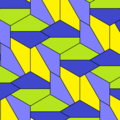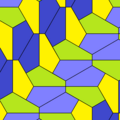| Mathematical Association of America Washington, D.C. | |
Marjorie Ruth Rice (née Jeuck; 1923–2017) was an American amateur mathematician most famous for her discoveries of pentagonal tilings in geometry.
Background
Rice was born February 16, 1923, in St. Petersburg, Florida.

Marjorie Rice was a San Diego mother of five, who had become an ardent follower of Martin Gardner's long-running column, "Mathematical Games", which appeared monthly, 1957–1986, in the pages of Scientific American magazine. By the 1970s, Gardner was a popular science writer and amateur mathematician. Rice said later that she would rush to grab each issue from the mail before anyone else could get it, especially her son who subscribed to the magazine.
In 1975, Rice read Gardner's July column, "On Tessellating the Plane with Convex Polygon Tiles", that discussed what kinds of convex polygons can fit together perfectly without any overlaps or gaps to fill the plane. In his column, Gardner indicated that "the task of finding all convex polygons that tile the plane …. was not completed until 1967 when Richard Brandon Kershner … found three pentagonal tilers that had been missed by all predecessors who had worked on the problem". Gardner was repeating Kershner's claim that the list of convex pentagon tilers was complete. But within a month, Gardner received an example, by one of his readers, Richard James III, of a new convex pentagon tiler, and published this news in his December 1975 column.
Discoveries of pentagonal tilings
Inspired by this new discovery, Rice decided to try to find other new pentagon tilers. Despite having only a high-school education, but a keen interest in art, she began devoting her free time to discovering new pentagonal tilings, ways to tile a plane using pentagons. She worked on the problem in her free time and through the 1975 holiday season "by drawing diagrams on the kitchen table when no one was around and hiding them when her husband and children came home, or when friends stopped by". She even developed her own system of notation to represent the constraints on and relationships between the sides and angles of the pentagons.
By February 1976, she had discovered a new pentagon type and its variations in shape and drew up several tessellations by these pentagon tiles. She mailed her discoveries to Gardner using her own home-made notation. He, in turn, sent Rice's work to Doris Schattschneider, an expert in tiling patterns, who was skeptical at first, saying that Rice's idiosyncratic notation system seemed odd, like "hieroglyphics". But with careful examination, she was able to validate Rice's results.
By October 1976, Rice had discovered 58 pentagon tilings that needed two pentagons stuck together in order to tile "transitively" (most of them previously unknown), which she arranged into 12 classes. By December 1976, she had discovered two additional new types of tessellating pentagons and over 75 distinct tessellations by pentagons that were in blocks that could be seen as "double hexagons". In December 1977, she made her fourth discovery of a new type of pentagon tiler and by then had enumerated 103 "2-block transitive" pentagon tilings. In the following decade, she discovered several more tiling patterns by pentagons and explored aperiodic tilings.
Rice had a keen interest in art, and had completed half of a correspondence course in commercial art before she married. Throughout her investigations, she explored how to use pentagonal tilings as grids on which to overlay tessellations of flowers, shells, butterflies and bees.
Rice's discoveries were never published in Gardner's Scientific American columns, but were revealed in an addendum to his original column that was included in his 1988 collection of columns, where he declared her discoveries "fantastic achievements".
"Much of Rice’s investigations remain unpublished, in that only the product of her investigations are shown. How she devised these is not generally shown. However, some of her investigations are indeed shown in The Mathematical Gardner, a compilation of articles in honour of the late Martin Gardner, with Doris Schattschneider’s article In Praise of Amateurs (mostly concerning background detail on Rice’s pentagon tiling findings), pages 140-166. Pages 154-155 contain numerous convex pentagon tilings".
Rice's archival fonds are at the University of Calgary Library, Alberta, Canada, in the Eugène Strens Recreational Mathematics Collection.
Four pentagonal tiling classes discovered by Marjorie Rice
Recognition while alive
Doris Schattschneider, who helped Martin Gardner popularize the pentagon tiling discoveries of Rice, lauded her work as exciting discoveries by an amateur mathematician.
In 1995, at a regional meeting of the Mathematical Association of America held in Los Angeles, Schattschneider convinced Rice and her husband to attend her lecture on Rice's work. Before concluding her talk, Schattschneider introduced the amateur mathematician who had advanced the study of tessellation. "And everybody in the room . . . gave her a standing ovation."
Legacy
- In 1999, one of Rice's tilings became the basis for the floor in the foyer of the headquarters of the Mathematical Association of America in Washington, D.C.
- Rice's papers and materials in support of her mathematical discoveries are preserved at the Eugène Strens Recreational Mathematics Collection at the University of Calgary Library, Alberta, Canada.
Personal life
Marjorie Ruth Jeuck married Gilbert Rice in 1945. She had six children, of whom one did not live past infancy.
Rice died July 2, 2017, in San Diego, California.
References
- ^ Mulcahy, Colm (October 28, 2015). "Martin Gardner at 101 ("It's as not-so-easy as 3, 4, 5")". Scientific American Blog Network. Retrieved 14 December 2021.
- ^ Peterson, Ivars (5 June 2010). "Tiling with Pentagons". The Mathematical Tourist. Retrieved 14 December 2021.
- "Building Guide" (PDF). Mathematical Association of America. Archived from the original (PDF) on February 17, 2005. Retrieved 14 December 2021.
- ^ Wolchover, Natalie (July 11, 2017). "Marjorie Rice's Secret Pentagons". Quanta Magazine.
- ^ Schattschneider, Doris (Spring 1996). "Perplexing Pentagons". Discovering Geometry Newsletter. 7 (1). OCLC 1001465604. Archived from the original on August 13, 2016.
- ^ Schattschneider, Doris (2017). "Marjorie Rice (16 February 1923–2 July 2017)". Journal of Mathematics and the Arts. 12 (1): 51–54. doi:10.1080/17513472.2017.1399680.
- ^ Cole, K. C. (March 11, 1998). "Beating the Pros to the Punch". Los Angeles Times. p. 1. ProQuest 421258615. Archived from the original on November 6, 2015.
- ^ Gardner, Martin (July 1975). "On tessellating the plane with convex polygon tiles". Mathematical Games. Scientific American. pp. 112–117. JSTOR 24949848.
- Britton, Jill. "Perplexing Pentagons". Distributed Education. Camosun College. Archived from the original on 9 January 2006. Retrieved 14 December 2021.
- Gardner, Martin (December 1975). "A random assortment of puzzles, together with reader responses to earlier problems". Mathematical Games. Scientific American. pp. 116–119. JSTOR 24949967.
- ^ Schattschneider, Doris (1981). "In Praise of Amateurs". In Klarner, David A. (ed.). The Mathematical Gardner (PDF). Boston: Prindle, Weber & Schmidt. pp. 140–166. doi:10.1007/978-1-4684-6686-7_16. ISBN 978-1-4684-6688-1. Reprinted as Mathematical Recreations: A Collection in Honor of Martin Gardner, Mineloa, NY: Dover, 1998
- ^ Schattschneider, Doris (2018). "Marjorie Rice and the MAA tiling". Journal of Mathematics and the Arts. 12 (2–3): 114–127. doi:10.1080/17513472.2018.1453740. S2CID 125461075.
- Pegg, Ed Jr. "The 14 Different Types of Convex Pentagons that Tile the Plane". mathpuzzle. Retrieved 14 December 2021.
- Gardner, Martin (1988). "Tiling with Convex Polygons". Time Travel and Other Mathematical Bewilderments. New York: W.H. Freeman. pp. 163–176. ISBN 0-7167-1924-X.
- Bailey, David. "Pentagon Tilings". World of Tessellations. Retrieved 14 December 2021.
-
- "Strens, Eugène". Archives. searcharchives.ucalgary.ca. Retrieved 16 December 2021.
- Guy, Richard K.; Woodrow, Robert E. (3 August 2020). The Lighter Side of Mathematics: Proceedings of the Eugene Strens Memorial Conference on Recreational Mathematics and Its History. American Mathematical Society. p. 7. ISBN 978-1-4704-5731-0.
- "Eugène Strens (1899-1980)". data.bnf.fr (in French). Retrieved 16 December 2021.
- "Marjorie Rice fonds". Archives. University of Calgary. Retrieved 16 December 2021.
- Weisstein, Eric W. "Pentagon Tiling". MathWorld. Retrieved 14 December 2021.
- Fischer, Maria (2016). "Tiling the plane with equilateral convex pentagons" (PDF). Parabola. 52 (3). School of Mathematics and Statistics, University of New South Wales Sydney. ISSN 1446-9723. Retrieved 14 December 2021.
- "San Jose Mercury News". Archives. searcharchives.ucalgary.ca. Retrieved 16 December 2021.
File consists of news clipping of article featuring Rice from February 28, 1995 issue of San Jose Mercury News. Includes quotes from Marjorie and her husband, Gilbert, as well as quotes from Doris Schattschneider's lecture at San Francisco mathematics conference.
- Wolchover, Natalie (2017-07-11). "Marjorie Rice's Secret Pentagons". Quanta Magazine. Retrieved 2022-07-26.
Further reading
- Rice, Marjorie (2003). "Escher-Like Patterns from Pentagonal Tilings". In Schattschneider, Doris; Emmer, Michele (eds.). M.C. Escher's Legacy: A Centennial Celebration. Berlin: Springer. pp. 244–251. doi:10.1007/3-540-28849-X_24. ISBN 978-3-540-20100-7.
- Schattschneider, Doris (1978). "Tiling the Plane with Congruent Pentagons" (PDF). Mathematics Magazine. 51 (1): 29–44. doi:10.1080/0025570X.1978.11976672. JSTOR 2689644. Reprinted with Afterword in The Harmony of the World: 75 Years of Mathematics Magazine, eds. Gerald Alexanderson and Peter Ross, Mathematical Association of America, 2007, pp. 175–190
- Schattschneider, Doris (1978). "Errata". News & Letters. Mathematics Magazine. 51 (4): 256. doi:10.1080/0025570X.1978.11976726. JSTOR 2689477.
- Schattschneider, Doris (2018). "Marjorie Rice and Her Pentagonal Tilings" (PDF). Bridges Stockholm 2018. Phoenix: Tessellations Publishing. pp. 1–2. ISBN 978-1-938664-27-4.
External links
- Marjorie Rice Intriguing Tessellations (home page) Archived August 20, 2007, at the Wayback Machine
- Pentagon Tilings demonstration - Wolfram Research
- Schattschneider, Doris. "The Story of Marjorie Rice". Gathering 4 Gardner Celebration of Mind – via YouTube.
- Sellaroli, Giuseppe; Garcia, Amanda (June 1, 2018). "A brief history of: pentagonal tilings (1918-2018))". Sequential Math.
cartoon with references








